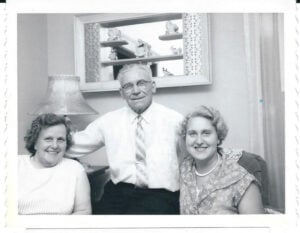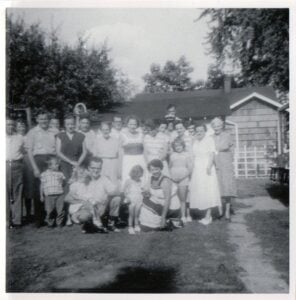 Anni Virta and Nelly Virta with their relative Everett Rintala on their 1960 trip to Ohio. Photo courtesy of Antti Virta
Anni Virta and Nelly Virta with their relative Everett Rintala on their 1960 trip to Ohio. Photo courtesy of Antti Virta
“Goodbye Helsinki,” Anni Virta wrote in July 1960, “our trip to the west has started and the point of the dream has become a reality.” Anni was a cousin by marriage. An English translation of her diary came to me recently through a serendipitous connection.
Anni’s nephew, Antti Virta of Helsinki, had written to the daughter of one of my cousins, making the connection via WikiTree, asking for information about his aunt Mary Rajasilta, wife of my mother’s brother, George Isaacson. Busy with an ailing mother, my cousin’s daughter bounced Antti’s request to me. I looked up some information about Aunt Mary in American records for Antti. And there began a pleasant correspondence.
Antti mentioned that he had his aunt Anni’s diary from a trip she made to Warren, Ohio, in the summer of 1960 with her niece, Nelly. Was I interested in reading a translation? Indeed I was! After all, Warren is my hometown. In 1960 I was nine years old, living in the Warren area, and—given the large size of my mother’s family—I hoped I might see mention of people and places I knew.
I eagerly devoured each installment Antti sent: several dozen of them, spanning July to September 1960. Immediately I encountered my cousin Eleanor (Isaacson) Fulmer and her husband, George, who drove to New York City to pick up the travelers. And then there were Uncle George and Aunt Mary, who hosted Anni and Nelly for the three-month trip. I could envision George and Mary’s house, as it was a favorite gathering place for my mother and her seven living siblings and their families. They were the children of Finnish immigrants, and George had large backyard (in which, of course, he had built a sauna).
I could envision George and Mary’s house, as it was a favorite gathering place for my mother and her seven living siblings and their families.
Early in the diary entries, I found a mention of “George’s old mother”: my grandmother Sandra Matalamäki Isaacson, who immigrated from Teuva, Finland, in 1900 and married John Isaacson in 1902.[1] And there was my Aunt Lillian and two of her children, and then mention of another visit to “George’s sister in the village.” Might this sister have been my mother? Perhaps, as we didn’t live in downtown Warren but, rather, in an outlying township, which you might have called a “village,” but it also could have been an aunt’s home. I don’t remember such a visit, but at 9 would I have paid close attention?
As I read the diary, I felt as if I was treading the landscape of my childhood once again: not only George and Mary’s house, but downtown Warren, and Mosquito Lake Reservoir, and the country roads. In addition, I was seeing it—and America—through the puzzled eyes of a foreigner: Anni marvels at all the traffic, and the speed with which Americans drive. She has never seen people eat so much, and in Finland you would never get such large “doses” of ice cream. She has never seen a boat on wheels, hauled behind a car. She finds some English terms funny: What is a body shop? Does it have to do with corpses?
 An Isaacson family gathering at George and Mary Isaacson’s home, ca. 1955, five years before Anni and Nelly's visit.
An Isaacson family gathering at George and Mary Isaacson’s home, ca. 1955, five years before Anni and Nelly's visit.
Then, on August 12: “Grandma's children, all but one, were there with their families and then we ate in the garden and drank coffee.” The occasion was my grandmother’s eighty-fourth birthday, and I am certain I was there! We didn’t have many gatherings at Ruben’s, and I have a clear memory of a family party there from about that time, when I played with cousins on the banks of a creek. Although I don’t remember Anni and Nelly, to a 9-year-old accustomed to hearing Finnish spoken at family gatherings their visit may not have stood out. Anni doesn’t mention me or any other relatives by name, but nonetheless I felt a tug at my heartstrings to read this entry.
The diary entries are all the more poignant to me because within four months my grandmother would be dead, and, within a year, my mother. Only a few months after my mother’s death, my father’s employer transferred him, and we relocated 100 miles away from the Finnish relatives. Because of those circumstances, this diary records a time and a place that are particularly dear to me. Through an outsider’s eyes, I see the landscape of my childhood, a landscape that I want to revisit again, with my adult sensibilities, not only to be able to see my immediate and extended family but also to revisit aspects of simple daily life from sixty years ago.
I can picture myself in many of these places: running around with cousins in Uncle George’s backyard, having coffee cake at my grandmother’s house...
It reminds me again why history of our own past is so important to record. Anni’s diary is more precious to me than any diary that I might ever access from a more long-ago relative. I can picture myself in many of these places: running around with cousins in Uncle George’s backyard, having coffee cake at my grandmother’s house, going to a store in downtown Warren, fishing with my dad at Mosquito Lake.
Anni’s diary had one more treat in store for me, a brush with international history. In late September, quite homesick, she and Nelly go to New York City for their departure home. They spend the day of September 22 in the city while they work out some travel details. It is very hot, they walk a long time, and they stop for a Pepsi. All of a sudden, they hear a fire truck and see police motorcycles. It’s a motorcade!
It is President Eisenhower and, in a separate car, Nikita Khrushchev. Anni and Nelly had ended up walking to the United Nations without realizing it. Eisenhower was giving an address that day to the 15th General Assembly; Khrushchev would speak the next day (but would not bang his shoe until October 12). After reading all Anni’s writings relating to my personal history, as well as mid-twentieth-century social history, this anecdote about an international event felt like the icing on the cake—the extra dose of ice cream.
Note
[1] He was born Juho Isakkinpoika [Isaac’s son] Panttila.
Share this:
About Penny Stratton
A veteran of the book publishing industry, Penny Stratton retired as NEHGS Publishing Director in June 2016; she continues to consult with the Society on publications projects. Among the more than 65 titles she managed at NEHGS are The Great Migration Directory, Elements of Genealogical Analysis, Genealogist’s Handbook for New England Research, and the award-winning Descendants of Judge John Lowell of Newburyport, Massachusetts. She has written for American Ancestors magazine and is a regular poster on Vita Brevis. With Henry B. Hoff, Penny is coauthor of Guide to Genealogical Writing: How to Write and Publish Your Family History; she is also the author of several Portable Genealogists on writing and publishing topics.View all posts by Penny Stratton →